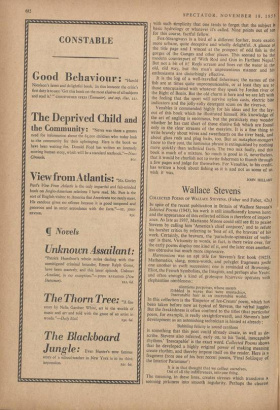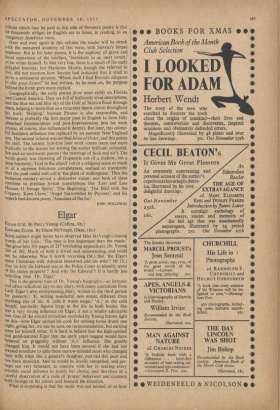Wallace Steven
COLLECTED POEMS OF WALLACE STEVENS. (Faber and Faber, 42s.) IN spite of the recent publication in Britain of Wallace Stevens's Selected Poems (1943), his work is still insufficiently known here; and the appearance of this collected edition is therefore of import- ance. As late as 1937, Marianne Moore could still see fit to praise
Stevens by calling him 'America's chief conjuror,' and to refute his harsher critics by referring to 'best of all, the bravura' of his work. Certainly, the bravura, the 'parachute-spinnaker of verbi- age' is there. Virtuosity in words, in fact, is there twice over, for the early poems display one kind of it, and the later ones another, less obtrusive but much more impressive.
Harmonium was an apt title for Stevens's first book (1923). Mathematics, slang, nonce-words, and polyglot fragments jostle
one another in swift succession; one is reminded of Browning. Eliot, the French Symbolists, the Imagists, and perhaps also Yeats;
and often enough a kind of grotesque bizarrerie operates with elephantine nimbleness:
silcntious porpoises, whose snouts Dibbled in waves that were mustachios. Inscrutable hair in an inscrutable world.
In this collection is the 'Emperor of Ice-Cream' poem, which has
been taken before now as typical of Stevens, the verbal juggler. But the freakishness is often confined to the titles (that particular poem, for example, is really straightforward), and Stevens's later development as an astonishing technician is hinted at already: Bubbling felicity in sound cantilenc is something that this poet could already create, as well as de- scribe. Stevens also referred, early on, to his 'lucid, inescapable rhythms.' Inescapable' is the exact word. Collected Poems shows that he developed, a highly original power of making meaning create rhythm, and thereby impose itself on the reader. Here is a
fragment from one of his best recent poems, 'Final Soliloquy of the Interior Paramour':
It is in that thought that we collect ourselves, Out of all the indifferences, into one thing.
The meaning, in these lines, creates stresses which transform a seeming jerkiness into smooth regularity. Perhaps the clearest tribute which may be paid to this side of Stevens's poetry is that he frequently obliges an English ear to listen, in reading, to an imaginary American voice. Over and over again in this volume the reader will be struck With the measured austerity of this verse, with Stevens's limpid euphony. But in his later poems, it is the euphony of grave and lucid operations of the intellect, 'Inanimate in an inert savoir,' as he writes himself. In that very line, there is a touch of the early Polyglot bravura; but Marianne Moore, though she referred to this, did not mention how Stevens had indicated that it tried to serve a substantial purpose. 'Where shall I find Bravura adequate to this great hymn?' he had written. As he went on, the purpose behind the hymn grew more explicit. Geographically, the early poems draw most richly on Florida and Central America. They are full of brilliantly vivid descriptions, and the blue sea and blue sky of the Gulf of Mexico flood through them, helping to leave blue as a recurrent theme almost throughout his work. 'Helping,' because Picasso is also responsible, and Stevens is probably the first major poet in English to have fully absorbed Impressionism and post-Impressionism into his work (music, of course, also influenced it deeply). But later, this colour- ful Southern influence was replaced by an austerer New England one. The second volume was entitled Ideas of Order, and this points the shift. The austere, ,hair-tine later work comes more and more explicitly to the reason for writing the earlier brilliant, colourful, lire-and-air-and-water poems ('the marriage of flesh and air'). The hurdy-gurdy was throwing off fragments not of a shallow, but a deep harmony; 'God in the object' not in a religious sense so much of a supreme felicitous completeness, realised so transiently that the poet could well call it 'the giant of nothingness.' Thus the technical mastery served a distinctive vision; and both of these combine to produce lyrical masterpieces like 'Less and Less Human 0 Savage Spirit,' 'The Beginning,' The Bird with the Coppery, Keen Claws,' 'Angel Surrounded by Paysans'; and his superb best-known poem, 'Anecdote of the Jar.'
JOHN HOLLOWAY











































































 Previous page
Previous page